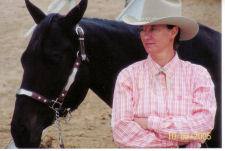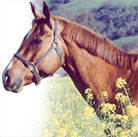| Article Archives
Starting
your own colt
Colt Starting
Quiz
Problem Horses,
part 1
Fear
Problems, part 2
Bad
Actors, part 3
The
Cold Backed Horse
Want
to Compete?
Bit Basics
Going
Places
Common
Sense, Horse Sense
Horsemen's
Christmas
Rainy Day
Training
Try Something
Different!
Green Broke
Resolution
Time
Going in
Circles
Hot Enough
for Ya?
Pleasure
or Equitation?
Return
to Work Carefully
Saving
your "Good Stuff"
Holding
Western Reins
Keep Your
Eyes on the Prize
Cold Weather
Warm Up
Expect
the Unexpected, 1
Expect
the Unexpected, 2
Bad Attitude
Horse of
a Better Color?
Power of
Exercise
Importance
of the Herd
Bath Time
Even Up
Choosing
a Martingale
Showmanship
A Good Night's Sleep
Alternative Therapies, Part One
Alternative Therapies, Part Two
Get the Most out of a Clinic
Blanket or No Blanket?
|
Does Practice
Makes Perfect?
Doris Eraldi
One of the more misunderstood aspects of horse training
is the idea that practice and repetition are necessary for
the horse to learn. We are told to “end on a good note” when
working with our horses, and it’s easy to misunderstand
that to mean repeating something – especially something
that is not going well – until we (or our horses) get
it right. This seldom works. If we are trying to do something
with our horses and it’s not going well, the situation
usually gets worse – more frustrating and exhausting – and
we fail to get that “good note” where we can
quit. Getting caught up in this spiral can be very detrimental
to both the horse’s training and the rider’s
confidence.
Horses learn quickly from positive reinforcement, and the
most positive experience that the horse has is the release
of pressure. If we are teaching the horse a basic cue, moving
away from the pressure of our leg, for example, the horse
will learn to move off sooner if we release the pressure
of our heel in his side the instant we feel him move away.
The horse will quickly associate moving away with the reward.
As this cue becomes more consistent, we can repeat the cue
to combine the movements. The leg yield across the width
of the arena is not one maneuver with one cue, but a long
series of small cues with releases in between (not to mention
the rider reacting to other aspects of the maneuver, such
as forward motion or placement of the shoulders or hindquarters).
Unfortunately for horses, humans like to practice. We tend
to approach a training session with some big goal such as
doing ten perfect circles or five good stops. This kind of
thinking tends to take us away from the communication with
the horse that can jump our training way ahead. I remember
watching a great trainer get out a young colt he was starting,
warming up slowly and finally trotting around for a short
while. When the trainer asked the colt for a stop along the
rail, the colt happened to drop his hindquarters and give
an above-average stop. The trainer sat there a moment, then
dismounted and put the colt away. He’d ridden for maybe
fifteen minutes. Did it take self control and an awareness
of a training opportunity for the trainer to quit when he
did? Certainly. Did he “end on a good note?” Absolutely!
If he had decided to do four more stops, would they have
likely been as good quality as that first one? Probably not ….
And there would go his chance to end on the good note. Did
that colt get a reward for trying extra hard that day? I
know that this trainer was well known for how his horses
stopped, and for how calm and confident they were. He made
it easy for the horses to learn each small cue with confidence,
so that as the horse’s education progressed, he could
string those small cues together and end up with a winning
performance as a hackamore or bridle horse.
For riders to develop the balance and coordination to be
skilled horsemen, they do have to practice. The more time
one spends on horses the better that feel and rhythm are
developed, but the riding time can (and should) be relaxed.
Long trail rides, working on a variety of skills and avoiding
the repetition that dulls up our horses also teaches the
rider to be well rounded. Riders should always be looking
for that training opportunity when the horse offers up a
better response to our cues and we have the chance to reward
him. If the rider is too focused on practicing one thing,
she might miss completely an opportunity to teach something
else.
The trainer I mentioned earlier? His horses
were the most versatile, well broke horses I’ve ever ridden. If you asked him
what a certain horse was in training for, he might answer that
it was a Futurity horse, or that it was going to be a Bridle
Horse. But if I ask what he was going to work on with a particular
horse that day, and he would think for a moment before answering, “Well,
I’m just going to ride him around a little.” Good
training is seeing the big picture while watching for the
small details.
 Doris
Eraldi of Eraldi Training in Potter Valley, specializes
in Pleasure, Showmanship and Equitation events. She can be
contacted at 707-743-1337, or by e-mail dyan@eraldi.net. Doris
Eraldi of Eraldi Training in Potter Valley, specializes
in Pleasure, Showmanship and Equitation events. She can be
contacted at 707-743-1337, or by e-mail dyan@eraldi.net.
<< Back
to Rainbow Ag Horse Home Page |
